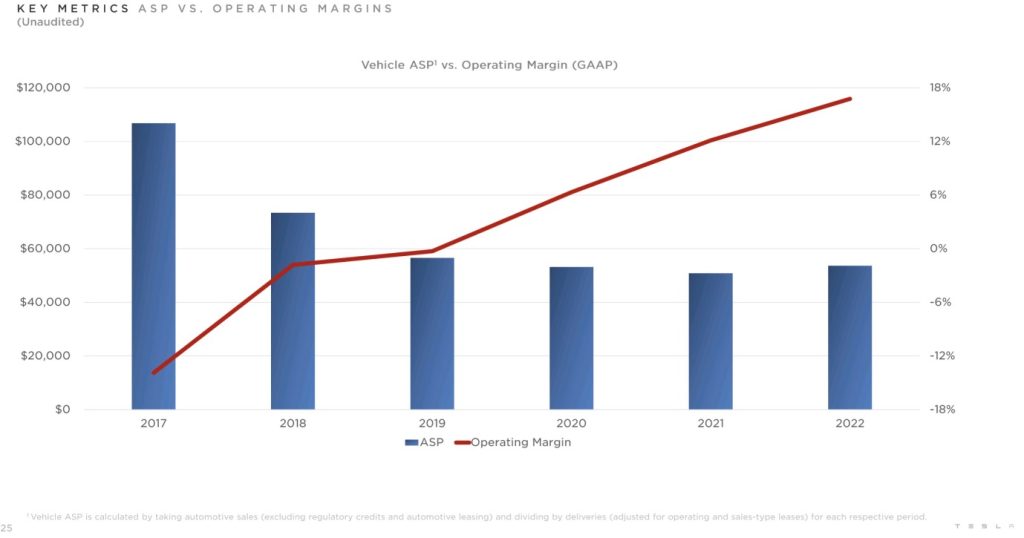
Tesla has managed to cut the price of its electric cars in half over five years, and it might do it again with its next-generation vehicle platform.
Much has been said of Tesla’s prices lately.
Despite its high prices, Tesla has attracted some non-luxury buyers over the years who have been willing to pay a premium to go electric, but it remains a luxury brand.
As a premium brand, the automaker competes primarily with other luxury brands like BMW, Mercedes-Benz, Audi, and Lexus.
But it has been gradually going down market over the years – albeit for massive price increases over the last two years that put even its entry models out of reach of most buyers.
Last month, Tesla implemented some significant price cuts across its entire EV lineup that made its vehicles more affordable, but they still all sit firmly in premium categories.
As we previously reported, the price drop might have started a new EV price war, and Tesla is in a great position to win that war thanks to its industry-leading gross margin.
The automaker has managed to cut its average sale price by half since 2017 while improving its operating margin from negative 15% to now more than 15% in the black:

That’s despite prices going slightly up in 2022, breaking the trend for the first time.
However, prices are expected to go down significantly in 2023 with the big price cuts to start the year.
But it’s most exciting to look into the future as there’s potential to see Tesla’s prices cut in half, or close to it, again over the next five years – thanks to its next-generation vehicle platform about to be unveiled.
Tesla third-generation platform
The Model S and Model X were based on Tesla’s first-generation vehicle platform. Model 3 and Model Y were based on the second generation – even though Model Y ended up featuring many improvements over Model 3.
Now Tesla is getting ready to unveil its third-generation vehicle platform at its Investor Day on March 1.
There are not many details available about Tesla’s new platform, but it is expected to focus on reducing cost and improving manufacturability to achieve a new level of scale.
More specifically, the new platform is expected to take advantage of Tesla’s 4680 battery cell, structural battery pack design, and its latest large casting technology to achieve a new level.
Today, Musk indicated that he will release Tesla’s Master Plan Part 3 at the event, and he has made clear on many occasions that the plan will be about how the automaker plans to scale to 20 million vehicles per year.
The plan is expected to include Tesla’s deeper involvement through the entire battery material supply chain, including more factories to refine minerals like lithium and nickel, as well as more vehicle and battery factories.
This supply chain and manufacturing plan along with the new vehicle platform is likely to enable Tesla to produce vehicles in new categories – even potentially an eventual $25,000 compact vehicle that would increase Tesla’s scale and greatly reduce its average sale price.
Electrek’s Take
It’s hard for people to imagine Tesla ramping up to 20 million vehicles per year, but it was also hard for most people to imagine Tesla ramping up to 1 million units.
The company not only did that, but it now sits at a capacity to produce 2 million cars per year.
It won’t be easy to 10x that capacity in seven years, but I think it’s doable.
Top comment by Les Inanchy
Whatever discussion of a low cost, Tesla comes up, I’m a little confused about how they can produce a $25,000 car and then continue to sell autonomous software for $15,000. I guess those cars will not be part of the program. And please don’t Make the case for the value of using the cars as Robotaxis. I’m assuming if somebody needs to buy a car in the $25,000 range, it’s because they need that card for themselves for their own transportation to get to work.
However, production is just one side of things. Tesla also needs cheaper offerings in order to have the demand for anything near 20 million vehicles per year.
If the automaker achieves self-driving capability, it would certainly be an easier sale, but putting that aside, Tesla is likely limited to about 3 million potential sales per year with its current lineup.
Electric pickups, like the Cybertruck, could bring that up to 5 million units without having to average down the sale price, but everything else will likely have to come from new segments lower than $40,000.
That’s why all eyes should be on that presentation on March 1 since it should give us a better idea of how Tesla plans to deliver on those ~15 million vehicles per year that are hard to imagine right now.
FTC: We use income earning auto affiliate links. More.





Comments